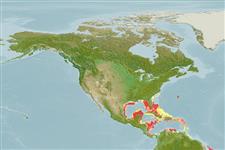Common names from other countries
Classification / Names / Names
Nombres comunes | Sinónimos | Catalog of Fishes (gen., sp.) | ITIS | CoL | WoRMS
Environment: milieu / climate zone / depth range / distribution range
Ecología
Pelágico; salobre; rango de profundidad 0 - 274 m (Ref. 116013). Tropical
Distribución
Países | Áreas FAO | Ecosistemas | Ocurrencias, apariciones | Introducciones
Western Central Atlantic: Belize and Bermuda. Tropical and subtropical.
Length at first maturity / Tamaño / Peso / Age
Maturity: Lm ? range ? - ? cm
Epibiotic but also found in the oceanic surface (epipelagic), neustonic (Ref. 116013). Known from mangroves (Ref. 86642, 86643) sheltered areas of bays and surface or near surface water layers, including porpitids and the halopelagic Sargassum fauna (Ref. 86643).
Life cycle and mating behavior
Madurez | Reproducción | Puesta | Huevos | Fecundidad | Larva
Members of the order Anthoathecata are mostly colonial A-form hydroids. Life cycle: The zygote develops into planula inside the gonophore and is later released as an actinula which metamorphoses into polyp stage.
Bouillon, J. and F. Boreo. 2000. (Ref. 3134)
IUCN Red List Status (Ref. 130435)
CITES status (Ref. 108899)
Not Evaluated
Not Evaluated
Threat to humans
Harmless
Human uses
| FishSource |
Herramientas
Más información
Age/Size
Crecimiento
Length-weight
Length-length
Morfología
Larva
Abundancia
Fuentes de Internet
Estimates based on models
